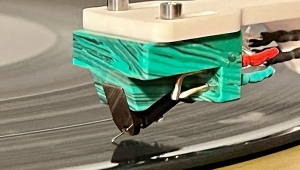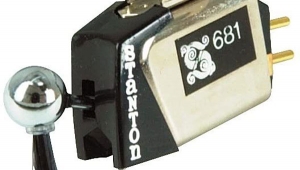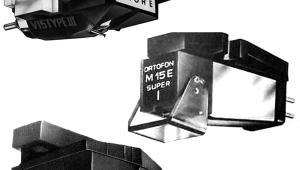| Columns Retired Columns & Blogs |
London (Decca) Jubilee/Reference phono cartridge Fremer on the London Reference
Sidebar 3: Michael Fremer on the London Reference, June 2005 (Vol.28 No.6):
The name had to be changed because of trademark issues, but this is the latest incarnation of the unusual and highly touted Decca cartridge that, in one form or another, has been around for decades. Everything I've ever read about this controversial design is true: It's one of the most alive, exciting, "direct-from-disc" cartridges I've ever heard. Once you've heard one of these doing what it does best, which is not everything, everything else sounds as if delivered via a tin can and string. (Okay, I'm exaggerating. A bit.) On the other hand, it's a bitch to set up exactly right, doesn't track all that well when you're done, and seems to prefer certain kinds of music, and even particular pressings.
The London Reference ($4495) has no cantilever in the conventional sense. The stylus—in this case an ultra-low-mass fine-line design—fits into the tip of an L-shaped tempered steel blade that protrudes down through a cartridge body newly designed by Avid's Conrad Mas. The other end of the L is clamped tightly within the body. A tiny tie-back cord affixed to the vertical "cantilever" just above the stylus is literally tied back and attached to the same set of clamping plates holding the other end of the L-shaped blade, thus creating a spring. The stylus end of the L passes through a coil-and-pole-piece assembly that tracks the lateral motion, while another coil and magnet at 90° to the lateral one registers the L piece's vertical movement.
This design evolved from the original mono cartridge design, which is why the second coil assembly sits atop and at 90° to the original lateral (mono) coil, instead of in the 45°/45° configuration found in most, if not all, other stereo cartridges.
The result is a direct, low-mass connection between the stylus/groove interface and the current-generating system, which uses the sum/difference principle with a common ground. The result is also a system in which the horizontal and vertical compliances are very different—medium and low, respectively. And while a small amount of damping material is inserted between the lateral coil and the clamped end of the steel blade, there is not the usual cantilever damping, so a damped tonearm is recommended. The Reference's output is huge: 5mV.
I installed the London Reference in the Immedia RPM tonearm. When I measured the vertical and horizontal resonant frequencies, they were quite different, but both were within the acceptable range—a good start. Tracking and antiskating force settings made enormous differences in getting this cartridge to sound right and track correctly. Anywhere between 1.5 and 2gm is recommended. Your results may well differ, so I won't list mine. The suggested vertical tracking angle (VTA) is dead parallel with the record surface.
I had some serious grounding issues with the London Reference. While the cartridge was silent through both the Musical Fidelity kW and the Graham Slee Gold Mk.V phono preamps, I couldn't eliminate a nasty hum through the Whest PhonoStage.20 or the Aesthetix Rhea. Nothing worked, including removing one of the cartridge's ground clips, as recommended by its manufacturer, the UK's Presence Audio.
You have never heard a snare drum or cymbal retrieved from a vinyl groove until you've heard what the London does. When tracking correctly, its transient delivery was nothing short of astonishing—by a laughable margin, the most realistic I've ever heard. The entire drum kit, in fact, from the kick drum up, left my mouth agape. The same with voices, which were delivered with a coherence—a wholeness—that was scary with the lights out. Rhythmically, dynamically, and, to a lesser degree, spatially, the London Reference is in a league of its own. It speaks with a single voice of authority as has no other cartridge in my experience.
I just got Pure Pleasure's reissue of Last Night's Dream (PP 7-63212), a Johnny Shines LP I've wowed show crowds with for years. My American Blue Horizon edition is good, but this Pallas pressing, cut by Ray Staff from the original analog tape, is much, much better. Recorded in Chicago at famous Ter-Mar Studios, Last Night's Dream is made for the London Reference—as is Classic Records' reissue of Willie Nelson's Stardust. But not everything fared as well; in terms of both music and noise, it was difficult to predict what I was going to hear when I dropped the stylus in a groove. Some records that are silent when tracked by the Lyra Titan were full of pops, ticks, and other garbage through the London.
Some think the London tears through vinyl, but after playing some discs repeatedly, I didn't find that to be the case. Setup, however, is critical—the utter lack of "wiggle room" is made more of a challenge because you can barely see the stylus tucked underneath the body, and there's no cantilever with which to reference the zenith angle. And the London horribly mistracked some records and had difficulty with sibilants on others.
Would I make the London Reference my primary cartridge? No—its performance is too unpredictable. Would I recommend it for use as an auxiliary cartridge on a second tonearm? If you can drop $4495 and not worry and you play lots of jazz and rock, don't hesitate—you'll get your money's worth with every play, and you'll play it more often than not. There's a mono configuration available, and as a mono cartridge—its original purpose in life—it must be stunning.—Michael Fremer
- Log in or register to post comments



































